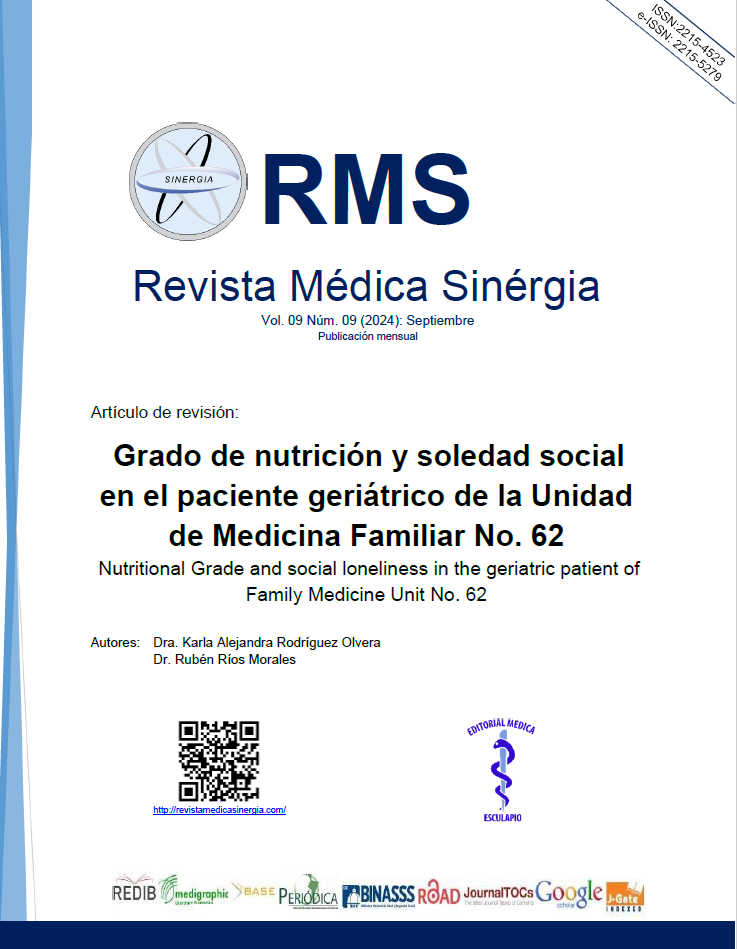Abstract
Introduction: The OPS considers a person aged > 60 years to be geriatric. In this study protocol, the association between nutritional status and social loneliness will be estimated, since at this stage of aging patients are usually abandoned by their relatives, bringing with them changes and nutritional deficiencies.
Material and methods: An observational, analytical, cross-sectional and prospective study will be carried out. Using the formula for a sample calculation of a finite proportion with a calculated sample of 365 patients, using simple random sampling. Entitled patients will be included, aged 65-75 years and who sign the informed consent. Mini Nutritional Assessment will identify malnourished elderly with Cronbach's alpha of 0.9 and ESTE II Scale that evaluates social loneliness with a Cronbach's alpha of 0.72.
Results. A study was carried out to determine the association between the degree of nutrition and social loneliness in 365 patients assigned to the UMF No. 62 IMSS, where 32.1% (117 patients) were found with a low degree of loneliness, with a degree of Medium loneliness was found in 42.2% (154 patients) and with a high degree of loneliness in 25.8% (94 patients).
Conclusion: In conclusion, we can say that our research work showed us that malnutrition in geriatric patients is related to high social loneliness.
Keywords
References
Janery Tafur Castillo MG. Factors that affect the nutritional status of the elderly. Revista Latinoamericana de Hipertensión. 2018;13(5).
Aguilar J. Factores que determinan la calidad de vida de las personas mayores. International Journal of Developmental and Educational Psychology INFAD. 2021;4(1):161-168. ISSN: 0214-9877.
Mella R. Factores Asociados al Bienestar Subjetivo en el Adulto Mayor. PSYKHE. 2004;13(1):79-89.
Barros Lazaeta C. Factores que intervienen en el bienestar de los adultos mayores. CPU. Estudios Sociales. Santiago. 2020;77.
OMS. 2019. Ciudados amigables con el mayor estado nutricional: Una guía. Río de Janeiro, Brasil.
Organización Panamericana de la Salud. Enseñanza de la enfermería en salud del adulto mayor. Serie. Recursos humanos para la salud. Washington, D.C.: OPS; 2022;(59).
Albala C, Lebrão ML, León Díaz EM, Ham-Chande R, HennisAnselm J., Palloni A, et al. Encuesta Salud, Bienestar y Envejecimiento (SABE): metodología de la encuesta y perfil de la población estudiada. RevPanam Salud Pública [Internet]. Jun, 2005 [cited Nov 21, 2016];17(5-6):307-322.
Ávila C, Roberta R. Estudio de investigación sobre la mortalidad en los adultos mayores en la guajira. 2018;23:8-10.
Riveros Ríos M. Valoración de factores biopsicosociales determinantes del riesgo de desnutrición en los adultos mayores en hogares de ancianos. An. Fac.Cienc. Méd. (Asunción). 2020;48(2).
Jiménez Sanz M, Sola Villafranca JM, Pérez Ruiz C, Turienzo Llata MJ, Larrañaga Lavin G, Mancebo Santamaría MA, Hernández Barranco MC. Estudio del estado nutricional de los ancianos de Cantabria. 2021;26(2):345-354.

This work is licensed under a Creative Commons Attribution-NonCommercial 4.0 International License.
Copyright (c) 2024 Array


